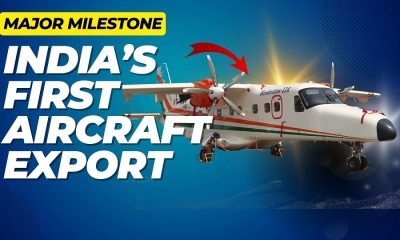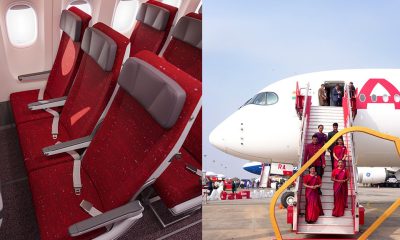Aircraft comparison
Comparison between Dornier-228 v/s Indonesian N219
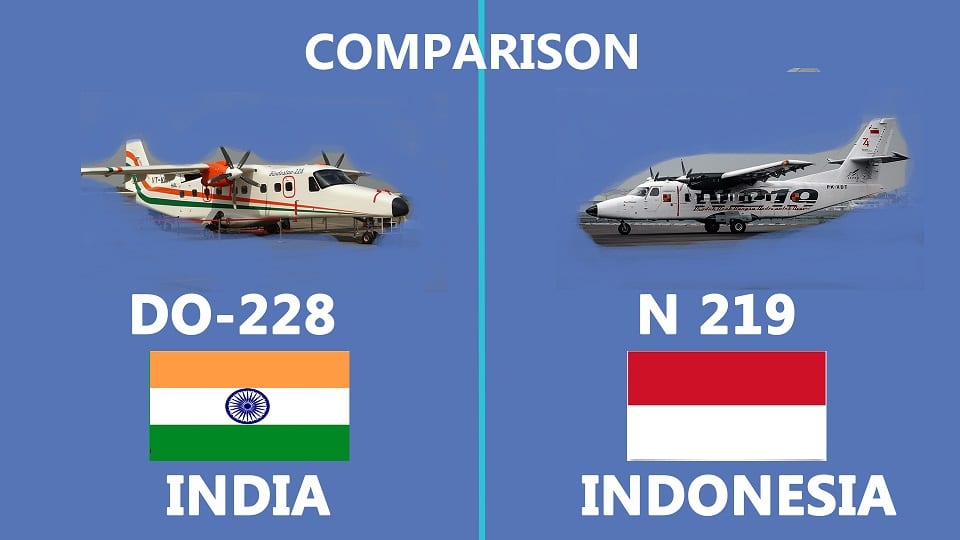
In this article, we’ll talk about two different types of airplanes: the Dornier-228 from India and the N-219 from Indonesia.
Indian Dornier-228 specification
The HAL Dornier 228 is a twin-turboprop utility aircraft that was created by Hindustan Aeronautics Limited (HAL), an Indian state-owned aerospace and defense firm, in collaboration with Dornier Flugzeugwerke, a German aircraft manufacturer.
The Dornier 228 is a versatile aircraft that can perform a number of tasks, such as passenger transport, transporting cargo, and conducting maritime surveillance. To support these diverse missions, it is outfitted with a variety of equipment and sensors, including radar, a searchlight, and a forward-looking infrared (FLIR) camera.
The first Dornier 228-100 entered service in Norving’s fleet in July 1982 after being developed in the 1980s. It is currently in use by numerous military and civilian operators all over the world, including the Indian Coast Guard and the Nepal Army. The Dornier 228 has a maximum seating capacity of 19 passengers and a ferry range of about 2,363 kilometers.
Comparison of global 7500 v/s Gulfstream 700(Opens in a new browser tab)
Indonesia’s N219 specification
Let’s speak about the N219 aircraft, which is a new generation multi-purpose aircraft with the largest cabin cross-section in its class, a proven and efficient engine, a modern avionics system, fixed tricycle landing gear, and a wide cargo door to make changing aircraft configuration easier. As a result, N219 Nurtanio is designed to give operators with technical and economic benefits.
The Indonesian N219 is a regional turboprop aircraft being developed by Indonesian aircraft manufacturer PT Dirgantara Indonesia (PTDI). It is intended to replace Indonesian airlines’ outdated fleet of Fokker 27 and Fokker 28 aircraft. The N219 has a ferry range of around 1,533 kilometers and it has a seating capacity of around 19 to 21 passengers.
The N219 project began in 2015, and the prototype debuted on 16 August 2017. It is anticipated that the aircraft, which is now in the testing and certification phase, would soon begin flying for Indonesian airlines.
This aircraft may be employed for a variety of missions, including passenger and troop transport, freight and medical supplies, surveillance, and patrolling.
The selling price of N219 aircraft, according to PTDI’s Production Director, Arie Wibowo, is in the region of US $ 6 million per unit, or roughly Rp 81 billion.
She fell 10,000 ft to earth strapped to a seat and lived..!!(Opens in a new browser tab)
Both the Indonesian N219 and the HAL Dornier 228 are regional transport aircraft used for short-haul flights. However, there are several key differences between these two aircraft:
- Manufacturer: The HAL Dornier 228 was developed by Hindustan Aeronautics Limited in partnership with Dornier Flugzeugwerke, while the Indonesian N219 is being developed by PT Dirgantara Indonesia.
- Size: The N 219 aircraft is 54 ft 1 inch in length, 64 ft 0 inch in wingspan, and 20 ft 3 inch in height. The Do 228 has a length of Length 54 ft 4 in, a Wingspan of 55 ft 8 inches, and a Height of 15 ft 11 inches.
- Design: The Dornier 228 is a high-wing aircraft with twin turboprop Honeywell engines, whereas the N219 is a similar high-wing aircraft with twin turboprop Pratt & Whitney engines.
- Capacity: The Dornier 228 can seat up to 19 passengers, whereas the N219 can accommodate 19-21 passengers.
- Ferry Range: The Dornier 228 has a ferry range of approximately 2,363 kilometers, while the N219 has a range of around 1,533 kilometers.
- Role: The Dornier 228 is a multi-role aircraft that can perform passenger transport, cargo transport, and maritime surveillance. The N219 is primarily designed for regional transport use.
- Status: The Dornier 228 has been in service for several decades and is currently in use by a number of military and civilian operators across the world. The N219 is currently undergoing testing and certification and is anticipated to enter service with Indonesian airlines in the near future.
- Dornier 228 aircraft has a range of 396 km and Indonesian N 219 has a range of up to 890 km.
- As of now, HAL has built nearly 125 aircraft and Indonesia N 219 has now received 120 aircraft orders from regional airlines
- The HAL-built Dornier 228 and Indonesia’s N 219 aircraft have a price range is 6 million USD in regional cost per unit.

Aircraft comparison
Comparison of Osprey vs Chinook Helicopter

Helicopters play a crucial role in military and civilian operations worldwide, providing vertical take-off and landing capabilities, versatility, and mobility in various missions.
Among the widely recognized helicopters in military service are the Osprey and Chinook. Both have distinct designs and capabilities, tailored to meet specific operational requirements. In this comparison, we will delve into the features, capabilities, and roles of the Osprey and Chinook helicopters, examining their differences and strengths.
The V-22 Osprey is a tiltrotor aircraft, meaning it can take off and land vertically like a helicopter but also tilt its rotors forward to fly like an airplane. This design allows the Osprey to achieve higher speeds compared to conventional helicopters. The cruising speed of the V-22 Osprey is around 241 knots (277 mph or 446 km/h).
On the other hand, the Chinook helicopter, such as the Boeing CH-47 Chinook, has a cruising speed typically around 170 knots (196 mph or 315 km/h). While the Chinook is a highly capable and versatile helicopter known for its heavy-lift capabilities and reliability, it generally operates at lower speeds compared to the Osprey.
The comparison between an Osprey and a Chinook helicopter involves contrasting two distinct aircraft with different designs, capabilities, and purposes:
Dimensions:
- The Osprey has a length of 57 ft 4 in (17.48 m). while Chinook is significantly larger, with a length of 98 ft (30 m).
- Performance:
- The Osprey boasts a maximum speed of 275 knots (316 mph) and a range of 879 nautical miles (1,012 mi), making it faster and having a longer range compared to the Chinook.
- The Chinook has a maximum speed of 170 knots (196 mph) and a range of 400 nautical miles (460 mi), providing commendable performance but falling short of the Osprey in terms of speed and range.
- Powerplant:
- The Osprey is powered by 2 × Rolls-Royce T406-AD-400 turboprop/turboshaft engines, providing ample power for its vertical and horizontal flight modes.
- The Chinook is equipped with 2 × Lycoming T55-GA-714A turboshaft engines, each delivering 4,733 shp (3,529 kW) of power.
- Weight and Payload Capacity:
- Osprey: The Osprey has an empty weight of 31,818 lb (14,432 kg) and a gross weight of 39,500 lb (17,917 kg). Its maximum take-off weight (VTOL) is 47,500 lb (21,546 kg).
- Chinook: The Chinook has an empty weight of 24,578 lb (11,148 kg) and a maximum takeoff weight of 50,000 lb (22,680 kg). This indicates that the Chinook can carry heavier payloads relative to its own weight compared to the Osprey.
In terms of performance, the Osprey has a higher rate of climb ranging from 2,320 to 4,000 feet per minute, whereas the Chinook boasts a rate of climb of 1,522 feet per minute.
Additionally, the Osprey has a service ceiling of 25,000 feet, allowing it to operate in high-altitude environments more effectively compared to the Chinook, which has a service ceiling of 20,000 feet.
Osprey can carry up to 24 troops or 20,000 pounds of internal cargo and has a top speed of around 315 miles per hour (507 km/h). While Chinook can carry up to 55 troops or 24,000 pounds of cargo internally and has a top speed of around 170 miles per hour (274 km/h).
The Osprey is utilized by the U.S. Marine Corps, U.S. Air Force Special Operations Command, and other military forces around the world.The Chinook is widely used by the U.S. Army and various other military forces worldwide, including the UK, Canada, and others.
Aircraft comparison
Comparison of Russian Irkut MC-21vs Airbus A320neo
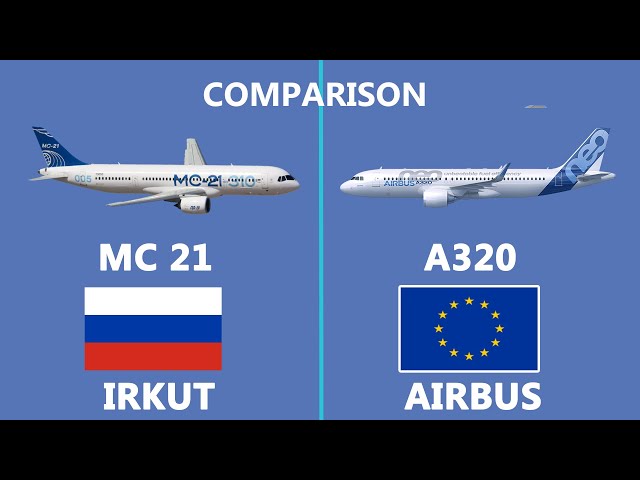
Russia is on the brink of advancing its aircraft industry in response to Western countries’ sanctions on aerospace components. They are developing a potential competitor to Western aircraft such as the Boeing 737 Max and the Airbus A320.
The Irkut MC-21 and the Airbus A320 are both narrow-body, single-aisle commercial aircraft designed for short to medium-haul flights. While the Airbus A320 has been a longstanding and widely used aircraft in the aviation industry, the Irkut MC-21 is a newer entrant that aims to compete in the same market segment.
In this article, we will conduct a comprehensive comparison between two notable aircraft: the MC 21 and the A320. Join us as we delve into each section to gain a better understanding of these aircraft and their capabilities.
mc 21
The MC-21, also called the Irkut MC-21, is a cutting-edge, contemporary narrow-body twinjet airliner built in Russia that was created and manufactured by Irkut Corporation. The MC-21, which made its first flight in 2017, is a technological be amazed at its advanced aerodynamics, fuel efficiency, and roomy, passenger-friendly cabin.
The well-known narrow-body, twin-engine Airbus A320 is now a mainstay of the world’s aviation fleet. Since its introduction in 1988, the A320 family has come to represent efficiency, dependability, and state-of-the-art technology. Airlines can choose the A320 series as a flexible option for short- to medium-haul routes with its unique wide cabin and sophisticated fly-by-wire control system.
In terms of cockpit crew, both aircraft accommodate a standard two-person crew. However, when it comes to passenger capacity, the MC-21-300 offers a configuration with 163 seats in a two-class setup (16J + 147Y), while the A320 has a slightly smaller capacity with a range of 140 to 240 passengers.
Moving on to dimensions, the MC-21-300 has a length of 42.2 meters (138 ft), whereas the A320 is slightly shorter at 37.57 meters (123 ft 3 in).
The MC-21-300 also has a wider wingspan, standing at an unspecified width, compared to the A320’s 35.8-meter (117 ft 5 in) wingspan.
The MC-21-300 has a maximum take-off weight of 79,250 kg (174,720 lb), slightly exceeding the A320’s maximum take-off weight of 78,000 kg (172,000 lb).
With a maximum payload of 22,600 kilograms (49,800 pounds), the MC-21-300 surpasses the A320, which has a maximum payload of 19.9 tons (44,000 pounds). This can impact the aircraft’s flexibility in carrying passengers, cargo, or a combination of both.
The MC-21-300 boasts a 2-class range of 6,000 kilometers (3,200 nautical miles), while the A320 has a range of 3,300 nautical miles (6,100 kilometers) under certain parameters. The MC-21-300 is equipped with Aviadvigatel PD-14 turbofan engines, while the A320 features the Pratt & Whitney PW1431G engines with a thrust of 31,000 lbf (140 kN).
Engine Upgrade
The Airbus A320 stands out as a popular aircraft in the narrowbody segment, offering a range that spans from shorter distances to longer routes. Airbus has extended its capabilities with the introduction of the much-anticipated A321XLR, designed for extended flights. The aircraft showcases breakthrough technologies that contribute to its overall advancement.
Notably, Airbus has experienced a higher number of orders for its narrowbody aircraft compared to its competitors. The A320neo, or “New Engine Option,” represents a significant leap forward. It boasts new engine choices, allowing airlines to opt for either the Pratt & Whitney PW1000G geared turbofan engine or the CFM International LEAP-1A engine.
In response to past challenges with one of its engines, Airbus is gradually transitioning to CFM engines. The previous engine-related issues resulted in setbacks for airlines and manufacturers alike. This shift underscores Airbus’s commitment to addressing concerns and ensuring the reliability of its aircraft.
The A320neo, an enhanced iteration of the A320, is a testament to Airbus’s dedication to incorporating cutting-edge technologies and more fuel-efficient engines. This evolution aims to improve overall performance while aligning with environmental sustainability goals.
As per reports from Russian sources, the Irkut MC-21 has achieved a milestone by successfully concluding over 160 test flights powered by the PD-14 engine. Furthermore, the aircraft’s wing has undergone a comprehensive test cycle, demonstrating positive endurance results. The PD-14 engine, developed by the United Engine Corporation (UEC), has played a pivotal role in the aircraft’s success, complementing the domestically produced composite wing.
Orders
Recently, Sergey Skuratov, the director-general of Ural Airlines, unveiled the carrier’s ambitious plan to acquire 40 Irkut MC-21s for its fleet. This announcement signals a noteworthy shift in Russia’s aviation landscape, as many airlines in the country are considering the adoption of domestically manufactured aircraft to replace their existing narrow-body planes sourced from Western countries. This move represents a significant milestone for Russia as it endeavors to establish a more prominent presence in the global commercial aviation sector.
While Airbus, with its extensive worldwide customer base and a substantial number of airplane orders, may not feel an immediate impact, the potential loss of the Russian market could pose challenges. The MC-21’s success in the Chinese market, in particular, could present hurdles for Airbus, given its significant market share. Despite facing sanctions on Western components, Russia continues to operate its A320 fleet, showcasing its resilience in meeting current and future demands for aviation passengers.
Aerospace
Boeing 777-8F vs Airbus A350F: Comparing two Premium aircraft
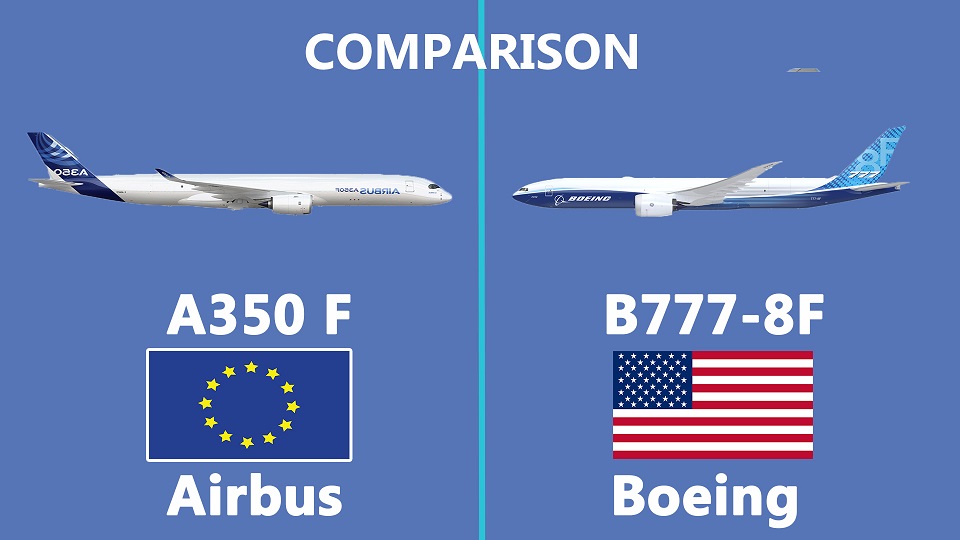
In the world of aviation, competition is a constant force. With the aftermath of the COVID pandemic, many airlines have been making a strong comeback, showing robust profit margins. Furthermore, the demand for freight services has been on the rise, necessitating the need for high-end aircraft in this sector.
In this narrative journey, we’re about to embark on, we’ll delve into the realm of two exciting newcomers in the freighter aircraft segment: A350 vs 777, The Airbus A350 Freighter, and the Boeing B777-8 Freighter.
These aircraft are born from the same lineage as their passenger counterparts but have been reimagined for the world of cargo transportation. Our exploration will take us through the fascinating similarities and differences between these two aircraft, examining their capacity, operational viability, and what they bring to the airlines that operate them.
Airbus A350F
The A350F can be seamlessly integrated into airline fleets, delivering step-change efficiency in terms of volume, range, and payload.
Airbus is proud to bring the A350F as the only choice for the future of the large widebody freighter market
The A350F, as proclaimed by Airbus, possessed an almost otherworldly ability: it showcased an unbeatable fuel efficiency that set a new benchmark for its competitors. With awe-inspiring prowess, it achieved a staggering 40% reduction in fuel consumption and carbon dioxide emissions when compared to the venerable 747F.
But the brilliance of the A350F didn’t end there. It was a revelation in seamless integration for airline fleets. As if answering the prayers of airlines worldwide, this aircraft seamlessly joined its ranks, ready to revolutionize air travel. Its introduction marked a step-change in aviation efficiency, touching every aspect of the industry.
Boeing’s 777x Aircraft and the Evolution of Air Freight
Boeing is keeping pace with advancements in aviation, showcasing its much-anticipated Boeing 777x aircraft, currently in the testing phase. Responding to Qatar Airways’ call, Boeing is exploring the development of a 777X-based freighter to replace the existing 777Fs.
This cutting-edge aircraft boasts next-generation avionics and technology, featuring a powerful engine that significantly elevates its performance. The extended wing structure not only enhances aerodynamics, reducing drag during cruising for improved fuel efficiency but also contributes to lower fuel consumption.
Introducing the 777-8 Freighter, Boeing extends its freighter family as the world’s most capable and fuel-efficient freighter, aligning with sustainability goals. The Boeing freighter family ensures optimal payload capacity and range capabilities, all while maintaining superior economics. This includes the high-volume 747-8 Freighter and the long-range 777 Freighter, solidifying Boeing’s commitment to delivering innovative solutions for the future of air freight.
| Boeing 777-8F vs Airbus A350F – Specifications | ||
|---|---|---|
| A350F | 777-8F | |
| Length | 70.8m | 70.8m |
| Height | 17.1m | 19.5m |
| Wingspan | 68.75m | 71.8m |
| Maximum take-off weight (MTOW) | 319,000kg | TBC |
| Cargo capacity main deck | 30 pallets main deck, 12 in lower hold | 30 pallets main deck, 12 in the lower hold |
| Total cargo volume | TBC | 766.1m3 |
| Net revenue payload | 109,000kg | 112,264kg |
| Range | 4,700nm | 4,410nm |
| Engines | 2x Rolls-Royce Trent XWB | 2x General Electric GE9X |
Boeing 777-8F and A350F Capacity
The A350F is derived from the A350-1000 and the 777-8F will have the key features of Boeing’s 777X design, including its carbon-fiber wing – the longest single composite part ever developed for an aircraft. The 777x vs A350 is unique in technology.
The 777-8F will be slightly larger than the A350F, with a marginally longer fuselage, taller height, and a wider wingspan. At 70.8m, the A350F will be slightly shorter than the 73.7 m-long passenger A350-1000.
On cargo payload and range, Airbus says the A350F will carry 109,000kg over 4,700nm. Boeing’s data notes the 777-8F will carry 112,300kg over 4,410nm.
And while the A350F’s main-deck cargo hold will have capacity for 30 pallets (measuring 244 x 318cm), with another 12 of the same size in the lower hold, the 777X will carry 31 pallets (again 244 x 318cm) on the main deck, and 13 in its lower hold. Essentially, the 777-8F will carry slightly more cargo, but the A350F will be able to fly further.
Boeing 777-8F and A350F efficency
Airbus stands to gain significant advantages by promptly introducing the A350F into service, recognizing the absence of a compelling cargo aircraft in its portfolio. Leveraging the already-established certification of the A350 family further reinforces its position.
In contrast, Airbus A350 vs Boeing 777. Boeing adopts a more measured approach, as the continued reception of orders for the 777F allows for sustained production over the next five years. This strategy provides a smoother transition toward the eventual production of the 777-8F.
The European aircraft manufacturer highlights that the A350 F will feature a 17% increase in revenue cargo volume and a payload capacity of 3,000kg greater than the current generation Boeing’s 777-9F.
In contrast, Boeing asserts that Boeing’s 777-9F will outperform the current Boeing 777F by carrying 17% more revenue payload. Boeing aims to provide the “highest payload and long-range capability” to explore new markets while ensuring a balance of “low operating cost with high reliability.”
Airbus emphasizes the A350 F unparalleled space for customers, claiming an 11% volume increase that accommodates an additional 5 pallets. The A350 F boasts a lighter Maximum Takeoff Weight of 30 tonnes and an impressive 99.5% operational reliability.
Further setting it apart, the Airbus A350 F features a cargo side door that surpasses competitors in size. Additionally, it promises a 20% reduction in fuel burn, contributing to enhanced efficiency and sustainability.
Airbus stands to gain significant advantages by promptly introducing the A350 F into service, recognizing the absence of a compelling cargo aircraft in its portfolio. Leveraging the already-established certification of the A350 family further reinforces its position.
In contrast, Boeing adopts a more measured approach, as the continued reception of orders for Boeing’s 777-9F allows for sustained production over the next five years. This strategy provides a smoother transition toward the eventual production of Boeing’s 777-9F.
B777-8F and A 350F orders as of Nov 2023
Currently, both freighter versions of these aircraft are pending. The Airbus A350, initially known for its passenger variant, is already operational in the market, catering efficiently to the passenger segment. Airbus is now extending its capabilities by developing the freighter version, scheduled for its maiden flight in 2026. Since its introduction in July 2021, Airbus has secured 39 firm orders for the A350F, with the unveiling of the inaugural aircraft’s livery at the Paris Air Show.
On the Boeing front, the 777-8F aircraft is undergoing a transition from the passenger to the freighter version. The cargo variant, 777-8F, is anticipated to be introduced in 2028. In contrast, the passenger version, 777-8, does not have a confirmed timeline. Qatar Airways, a major customer, has placed orders for approximately 74 aircraft, with additional orders from various other airlines, totaling around 90 aircraft as of 2023. Boeing currently leads in terms of order volume compared to Airbus.

